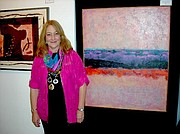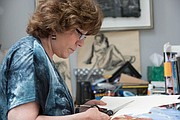Where and When
The mixed-media artists will open their studios to the public as part of the Great Falls Studios 2015 Studio Tour, which will be held Oct. 16-18 in Great Falls.
Hours vary by day: 12-5 p.m. on Friday, Oct. 16; 10 a.m.-5 p.m. on Saturday, Oct. 17; and 12-5 p.m. on Sunday, Oct. 18. Admission is free. Some of the artists will give demonstrations and others will provide “hands-on” activities for visitors.
The Great Falls Studios 2015 Studio Tour is sponsored by Great Falls Studios, a consortium of more than 100 artists who live or work in Great Falls.
Visit http://www.GreatFal…">www.GreatFallsStudi… to get a map and other information about the Tour.
Sun Design Remodeling is sponsoring the Tour again this year, and one of the tour stops will feature one of their recent remodeling projects.
The artist stands in front of her easel, painting. The next minute she agitatedly scribbles over the paint with charcoal, and then she grabs a piece of old postcard and forcefully slaps it onto the paint. Next she uses rubber alphabet stamps to write a word in ink on the painting. Maybe she paints another layer of white paint or gesso over much of the canvas or she sands off part of the paint. What is going on here? This is mixed-media art—art in which more than one medium is used in creating an artwork.
Great Falls mixed-media artist Beverly Sloper explains, “Mixed-media art is all about freedom... The artist has wonderfully varied techniques as well as endless materials available to launch each piece of art. You can let your mind run wild. The joy is in the journey.”
Sloper and eight other mixed-media artists are among more than 40 artists participating in the Great Falls Studios 2015 Studio Tour, which will be held Oct. 16 – 18. Now in its twelfth year, the Tour highlights the creativity of community artists and provides the public an opportunity to visit the artists in their studios.
Mixed-media artists often work with acrylic paint because of its quick-drying quality, although they may work in oil paint, or even oil and acrylic together. They use a variety of substrates such as paper, canvas, or board. In addition to paint, the other media cover a broad range. For example, Roberta Beasley uses acrylic paint and paper in her unusual mixed-media landscapes. The Great Falls artists, among them, use the following media: paper (including collage paper, painted papers, hand-made papers, postcards, hornet’s nest paper, and photos), oil bar or oil pastel, regular pastel, chalk, ink, water-soluble crayon or graphite, charcoal, gesso, marker (various kinds), gold leaf, glitter, plaster, modeling paste, fiber paste, cloth fabric, polymer mediums, tea, coal dust, and photo transfers. As long as this list is, it may not be complete, as mixed-media artists often try new media.
Why do mixed-media artists use more than one medium to make art? The short answer is that the artists enjoy working with multiple mediums. Great Falls artist Jennifer Duncan says, “I like the variety of different mediums and I can’t always get the effect I want just using paint….For me, creating mixed media abstract paintings allows me to play with color and texture in an unplanned way.” Mixed-media artists enjoy exploring new methods and materials to see what they can do with them. They may incorporate new media into their work to get more or different effects—such as luminosity, depth, or texture--than they can get with paint alone. Some materials--such as graphite, charcoal, or ink-- are especially good for line work; watercolor and acrylic paint may be favored for creating large areas of color, while collage paper provides small areas of intense color and texture. The use of new media, in addition to traditional painting, gives artists new ways of expressing themselves. It allows them to convey their stories with more texture and depth and lets the audience experience art in a different way.
Some mixed-media artists include raw materials or found objects. Artist Jo Fleming used hornet’s nest paper to suggest danger in a piece about environmental contamination and coal dust to suggest the effects of coal mining. Another artist, Gurusangat Khalsa, uses found objects such as stickers from produce and “treasures” she finds on outings, such as crushed soda cans. “Whatever else stretches the meaning of art supplies,” she quips.
Many mixed-media artists start their careers as painters. As they master their painting skills, they begin to explore other media, such as collage or photo transfer, that can be added to their paintings. Vandana Pamecha says that after starting as a single medium artist, she turned to mixed media to explore and express different moods, modes and texture. Not all mixed-media artists start this way, however. One of the Great Falls artists, Ronni Jolles, started by making paper but has shifted to gathering papers made around the world and layering them with acrylic sealants to make her artworks.
Mixed-media artists often work in layers. Usually the first layer is paint. The number of layers can vary; some artists start with one layer of paint, or perhaps a more fully developed underpainting, followed by collage paper or other media. Some artists draw on top of the paint and papers. They may continue this process of layering paint, paper or other objects or media, and drawing, again and again until the finished work meets their satisfaction. Some of the other methods that might be incorporated include printing, stenciling, gluing, or photographs. Layering creates a history to the painting, giving the viewer a way to track the artist’s creative steps.
Some artists apply many thin layers of paint--some transparent, some translucent, and some opaque—in different colors. Artist Mary Ellen Mogee says, “I like to construct the layers so that colors, shapes, and lines in the lower layers are visible (clearly or suggestively) through the upper layers. To me layers in a work add an element of mystery or a dream-like quality.”
Mixed-media artists may start an artwork with a subject or idea--such as a still-life setup, a photo of a landscape from a trip, or a personal memory. Artist Heidi Mraz crafts realistic portraits of collectible automobiles by tearing up automobile magazines. Other times the artist may just start applying paint or paper to substrate, letting the design and composition emerge as the artwork develops. Some artists let the paint flow on the substrate quite freely, giving it little or no guidance. In fact some artists work in new acrylic paints and media that are made expressly for pouring and dripping. Even when the artist begins with an idea for the painting, the idea generally evolves as the artist continues to work on it. Sometimes the best artwork results from the artist “going with the flow.”
Art lovers will enjoy the Great Falls Studios 2015 Studio Tour because it presents in one small geographic area the opportunity to visit artists who work in various media—from painting, photography and printmaking; through sculpture and ceramics, to jewelry and paper and fiber arts. Every artist's studio gives a peek behind the curtain to see the artists in their studios where they work their magic, to see their tools and media, to speak with them about their art, and to get a flavor of the creative environment and process.
All this is especially true in a mixed-media studio because of the wonderfully varied techniques as well as endless materials used by the artists. Just imagine the jars of paint, piles of found objects, bags of random papers, ephemera and old photos! Mixed-media artworks are interesting because they are something different; they transcend boundaries and break rules. They are all about freedom. Mixed-media art engages the viewer in a different way of seeing art and thinking about it.




